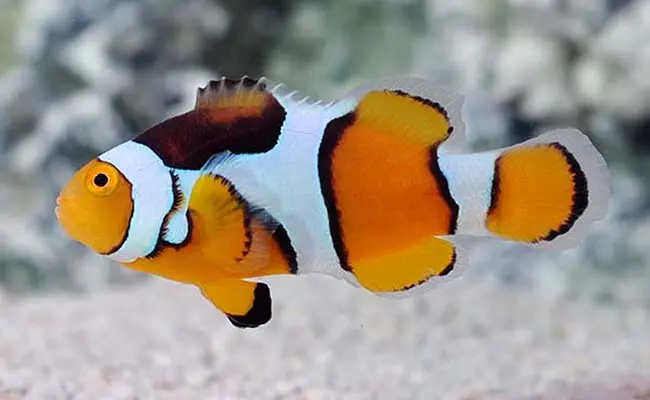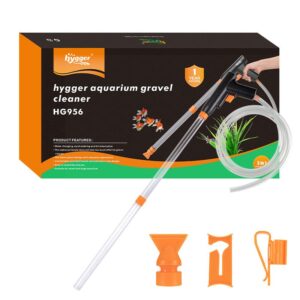Ever wondered how those adorable clownfish in your favorite Nemo movie end up in the tank? Breeding clownfish in a home aquarium can be a fascinating challenge, but it’s not without its difficulties. This guide will unveil the secrets of clownfish breeding, from choosing compatible varieties to spotting breeding cues.
Content Table
We’ll cover clownfish’s fascinating reproductive behavior, including frequency and methods to promote successful clownfish spawning in your tank.

Different Breeds of Clownfish
There are more than 30 different breeds of Clownfish which are also known as anemone fish. Each variety has different behavior, features, and physical traits. Let’s discuss some popular ones.
1. Ocellaris clownfish (Nemo)
| This type of clownfish is the yellowtail damsel clownfish, and it is the first to come to mind when speaking of clownfish. They are bright orange with white stripes and black tips which are found at the end of fins. Such are the clownfish featured as the main characters in the hit Disney movie “Finding Nemo”. |  |
2. Percula clownfish
| The orange clownfish looks very much like ocellaris clownfish but this one has some important variations. The stripes of the perculas are fatter, and the contour of their body is kept in black. Although the facial pattern of perculas and ocellaris clownfish is identical, they can be easily differentiated by their little brilliant blue ornament.
On top of this, a more prominent dark spot on their dorsal fin becomes apparent for the clownfish than for the ocellaris one. Percula clownfish are also mostly encountered in the water zones of the central and western Indian Ocean, the Red Sea, the Gulf of Aden, as well as the Arabian Sea. |
 |
3. Clark’s anemonefish
| This spectacular clownfish exhibits a distinct coloring, comprising black and yellow stripes alternating throughout its body. Majestic for its obvious spot – the neighbor of the dorsal fin also contributes its fair share of colors to the tiger shark.
The Clark’s anemonefish species is often found in the Indo-Pacific Ocean region, particularly in Indonesia and the Philippines and also near Japan. |
 |
4. Saddleback clownfish
| This particular clownfish gains the name for the bright white saddle-shaped spot present on its back. The saddleback clownfish, also known as the saddle anemonefish, comes in two main color varieties: orange and yellow. The Saddleback clownfish species is often recognizable with a staggeringly vivid orange body and a white saddle that starts from the level of the dorsal back and stretches till just a bit below the pelvic fins.
Yellow saddleback clownfish carry a vivid yellow body with its distinctive white saddle marked possibly with a touch of blue. Overall, both color variants of this species have black bodies and fins, and a small black stripe travels along their eyeline to their mouth. |
 |
5. Pink skunk clownfish
| These clownfish are anything but shy with their stunning red body and solitary, strikingly white lines running along their backs from head to tail. Such fish are often found in or adjacent to the Indo-Pacific Ocean in places like the Red Sea, Indian Ocean, Southeast Asia, and the Great Barrier Reef.
Unlike other clownfish species, the pink skunk clownfish are also known for forming symbiotic relationships with the various anemones they settle in, which protect them from predators among the anemone’s stinging tentacles and also help to keep the anemones clean and free of parasites. |
 |
Are Clownfish Easy to Breed in A Tank?
Breeding clownfish in a home aquarium is possible, but it’s more complex than simply keeping them healthy. While getting them to spawn is achievable, raising the tiny fry requires specific food and very stable water conditions. It’s best to be an experienced saltwater aquarist before attempting clownfish breeding.
Clownfish Breeding Behavior
Here are some signs that your clownfish might be ready for breeding:
Fish Size and Age
- Size: Generally, female clownfish are the larger of the breeding pair.
- Age: Ideally, your clownfish should be at least 12-18 months old before attempting to breed them.
Behavior
- Pairing: Clownfish are sequential hermaphrodites, meaning the dominant fish becomes female and the smaller one becomes the breeding male. Look for a well-established pair who spend most of their time together, often near a specific anemone (their host).
- Increased Activity: A breeding clownfish pair might exhibit more activity and cleaning behavior around a particular anemone. This cleaning behavior prepares the anemone for hosting the eggs.
- Aggression towards tankmates: The breeding female might become more aggressive towards other fish, particularly other clownfish, as she prepares to lay eggs.
- Laying Tube: The female will often spend time near the anemone’s oral disc (the mouth-like opening), wiggling her body. This is thought to stimulate egg production and may indicate she’s preparing to lay eggs.
Physical Signs
- Fullness: The breeding female’s abdomen may appear fuller and rounder than usual as she develops eggs.

How Many Times Can a Clownfish Reproduce
Clownfish are prolific breeders under the right conditions, able to reproduce multiple times throughout the year. Here’s a breakdown of their breeding schedule and habits.
Breeding Schedule
- Frequency: A thriving pair of clownfish can reproduce every 10-14 days when provided with the best possible conditions.
- Season: In contrast to many fish species, clownfish are not classified as seasonal breeders. They can annually be hatched as long as the water temperature and other environmental requirements are at optimum levels.
Breeding Habits
- Pairing: The male and female clownfish are monogamous, which means they will stay loyal to their spouse for the rest of their life. They form very strong pair bonds. The female is distinguished among the breeding pair by being larger and more self-assertive, whereas the smaller and less dominant fish is the male.
- Courtship: The mating process begins with the courtship performed by a male. Consequently, the behavior might be expressed in some methods like more chasing or body displays near the anemone.
- Egg Laying: The female lays her eggs directly in designated places usually near an anemone’s tentacles. The sperm of the male gets inside the eggs of the female and fertilizes them after the eggs are laid.
- Parental Care: The dominant male clownfish assumes the majority of the parenting assignment. He will devote his utmost attention to guarding the eggs, cleaning them, and producing current with his fins to provide oxygen. It thus allows to rain fungus and keeps eggs in perfect condition.
- Hatching: Usually, the egg hatches within 6-10 days after they are laid, but the rate of development is greatly influenced by the temperature of the water which also imputes the likelihood of hatching.
- Fry Care: Regretfully, most of the clownfish fry, in the wild, succumb to predation and various environmental conditions. When in a breeding environment, you must be aware of the fact that the fry will need to be raised in a secluded tank with nutrients that are provided by rotifers preferred.

Best Way to Breed Clownfish
There is always a serious discussion about the question: Can clownfish reproduce asexually?
Well, the answer is that Clownfish reproduction is entirely sexual. Despite being sequential hermaphrodites (fish can change gender), with all individuals starting as males, they cannot reproduce alone. They possess both male and female reproductive organs, but only the male sex organs are functional at birth. The switch to female is triggered by social cues within the group, not a need for self-fertilization. Fertile eggs require sperm from a male, making asexual reproduction impossible.
How do clownfish reproduce?
Clownfish are serial spawners, meaning a healthy pair can lay eggs every few weeks! They form monogamous pairs with the larger fish becoming female and the smaller acting as the male. The female lays eggs on an anemone, which the male then fertilizes. He takes on childcare duties, guarding the eggs until they hatch into free-swimming fry.
The Best Way to Breed Clownfish in Fish Tanks
Following is the standard way to breed clownfish:
Selecting the breeders
- Option 1: Purchase a mated pair from an aquarium store. These are the easiest to ensure breeding success.
- Option 2: Get a small juvenile male and a larger female. This allows them to form a pair bond as they mature.
Setting up the breeding tank
- Provide a breeding tile or anemone for the female to lay eggs on. Clay pots are a good alternative to anemones.
- Maintain excellent water quality with stable parameters (temperature, pH, ammonia, nitrite, nitrate).
- Keep lighting subdued as clownfish eggs are sensitive to bright light.
Encouraging breeding
- Offer a nutritious diet of live food like brine shrimp or high-quality frozen brine shrimp to keep the fish in top condition for breeding.
- Partially change the water regularly to simulate the environmental cues that trigger breeding in the wild.
Egg care
- The male clownfish will guard and care for the eggs.
- After hatching (around 8-10 days), you may need to move the fry to a separate tank for raising.
Raising the fry
- Provide infusoria or rotifers as the initial food for the tiny fry. These are microscopic live foods.
- Gradually switch to larger food sources as the fry grows.
- Maintain very clean water conditions in the fry tank.

Key Takeaways
Trying to home-breed clownfish is a challenging job but, on the other hand, it is also something magnificent. Clownfish are the sequential hermaphrodites (gender can change), females lay their eggs and males fertilize and look after the young. They can reproduce every two weeks, and this indeed determines the water environmental parameters within the special nursery areas. The breeders are at the minimum of 1 year old and an adult of mated pair is preferable.


Leave a comment